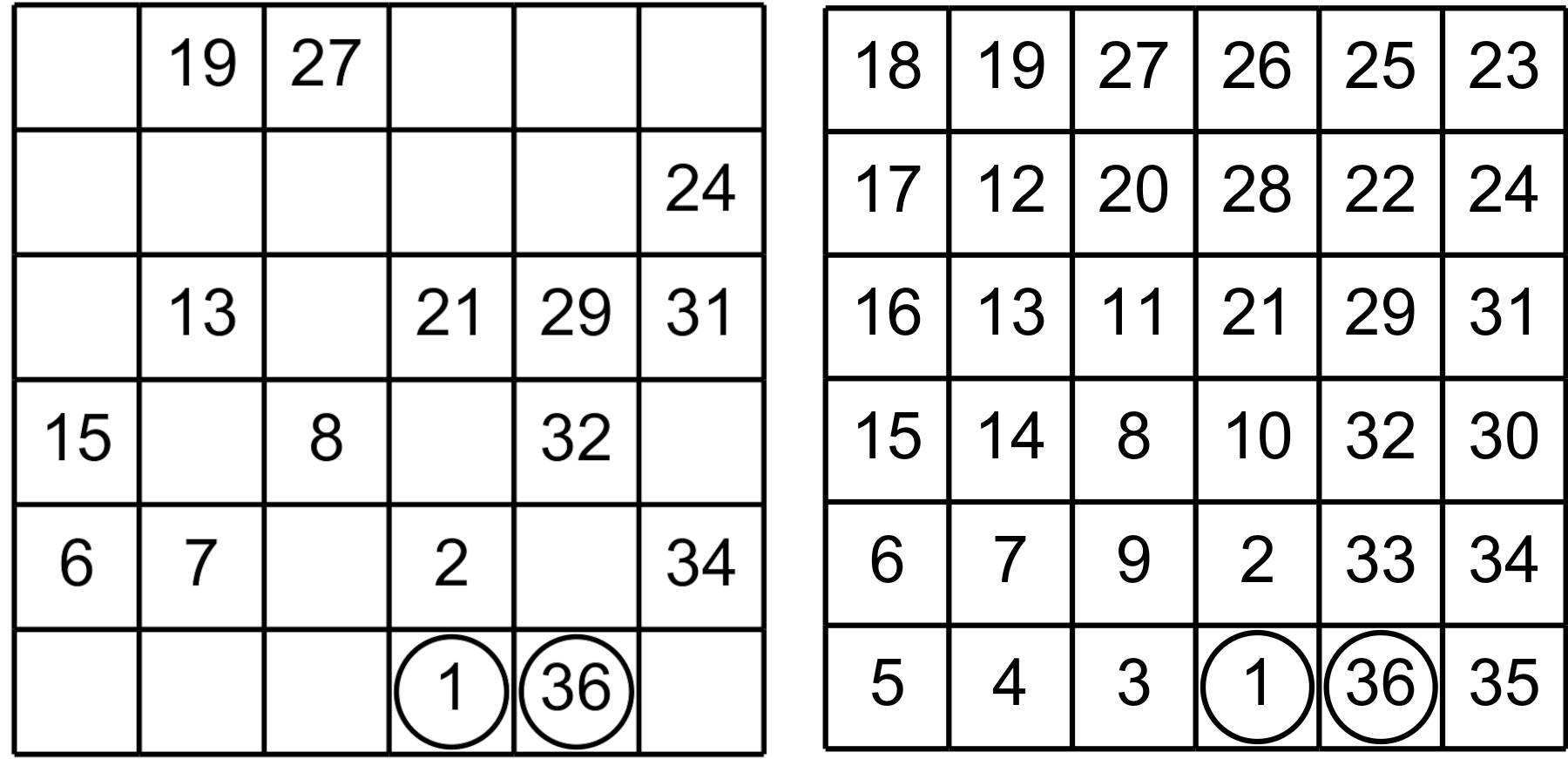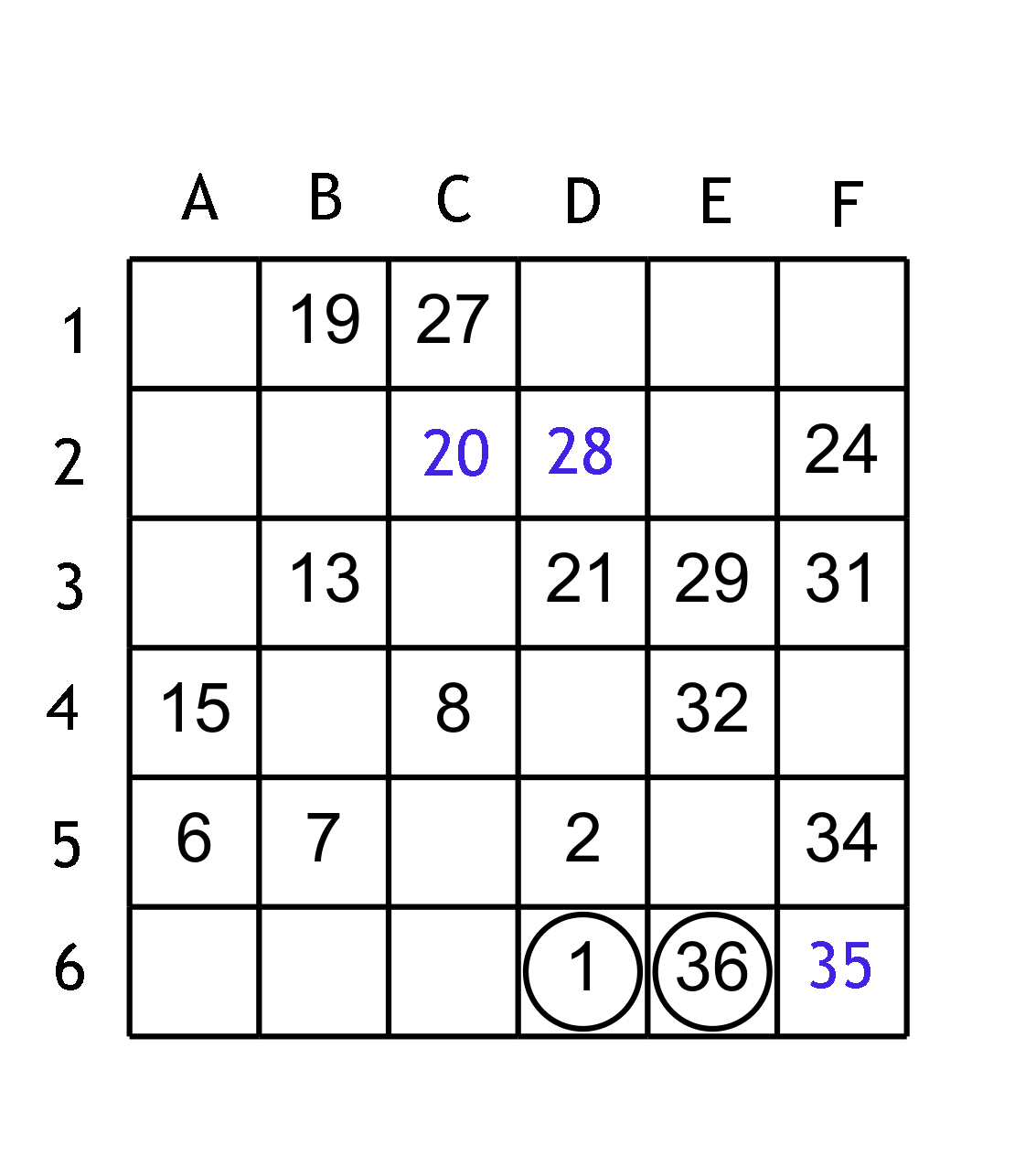HIDOKU
Goal
In a grid there is a path that runs through all the cells, the goal is to recreate this path by numbering each cells in order. The first and the last cell of the path are always identified by a circle. There are some cells of the path in the grid that are identified. The path moves from one cell another horizontally, vertically or diagonally, one cell at a time.

Figure 1
Here is an example of a puzzle with the solution. To complete this puzzle you must use logic. I will solve the game and explain you some solving tricks. I have added coordinates around the grid to make it easier to explain (Figure 1).

Figure 1
Gaps and paths.
At all times it is useful to keep track of the gaps and distances between two numbered cells, the gap is the number of missing digits and the paths are the possible paths between these cells that contain the missing numbers. If there is only one possible path then this path will contain the missing digits. This is easier to apply with one-cell gaps, because the number of paths is limited to paths that include only a single cell. For example, between 32 (E4) and 34 (F5) (Figure 1) the gap is only one square, so it must contain 33. On the other hand, there are two different paths to go from 32 to 34. Either by passing through cell E5 or F4. So we cannot determine where the 33 will be. But between 19 and 21 the gap is one cell to place the number 20 and there is only one path which is cell C2 so C2 has 20. The same thing between 27 (C1) and 29 (E3) there is only one path, D2 to place the number 28 (figure 3). This method can be applied when the gaps are larger (more than 1 cell), but it is usually towards the end when there are few free cells left.

Figure 2
Hole
Since the path must pass through all the cells, it is necessary to avoid having cells that can never be connected. For example, the gap between 34 (F5) and 36 (E6) can be filled by two paths, i.e. cell E5 and cell F6. If we choose E5 to place the 35. (Figure 3).

This creates a hole at cell F6, because it can never be connected to another cell. So the path must go through F6 and this cell has 35 (figure 4). This rule is useful to help for selecting the right cell. Note that creating a dead end, i.e. a cell that has a number and cannot be connected to another cell, is of the same kind: avoid.

The common cell
If there are several possible paths between two numbered cells, but in each of these paths there is cell that is commun to all the different paths and has the order in all paths, then this common cell is part of the path. For example, the gap is 2 cells between 21(D3) and 24(F2). There are two possible paths either through E2 and E1 or through E2 and F1. As E2 is the common cell to both paths then E2 will have 22. Obviously 23 will be in F1 otherwise if it is in E1 then F1 will become a dead end with 25 (the only exit of square 24 (F2)) and the puzzle cannot be completed.

The single exit / entry
If the path must continue through only a single cell then this cell contains the portion of the corresponding path. As you can see, the path from 24 ( F2) (figure 5) can only continue to E1, which will have 25 and by the same principle D1 will have 26. (Figure 6).

Candidates
There are some situations where you can limit the number of values that a cell can have, because it can reduce the number of possible paths between two cells. The 13 (B3) and the 15 (A4) are one cell apart and there are two possible paths A3 or B4. But since there are two empty cells between 13 and 15 and because 16 is not yet found, these two empty cells must have 14 and 16. So we can write down these candidates 14 and 16 in the cells A3 and B4 (Figure 7). Because these two cells cannot have other values.

Now we it is easier to see that the number 5 cannot go to B4 and must go to A6, because in B6 the 5 would create a hole in A6. The 5 will be in B6 and the 4 will be in C6 otherwise in C5 it would make a hole in C6. Once this is done, it is easy to connect the 8 to the 13 (Figure 8).

Finally the 14 must go to B4 and we continue to get the solution.

Solving a Hidaku requires thinking, the amateurs of logic games will be served by this puzzle. An attractive feature for the puzzle creator is that this puzzle can be created in several different sizes and also in several shapes. What I will demonstrate to you during the next months.

















Comments powered by CComment